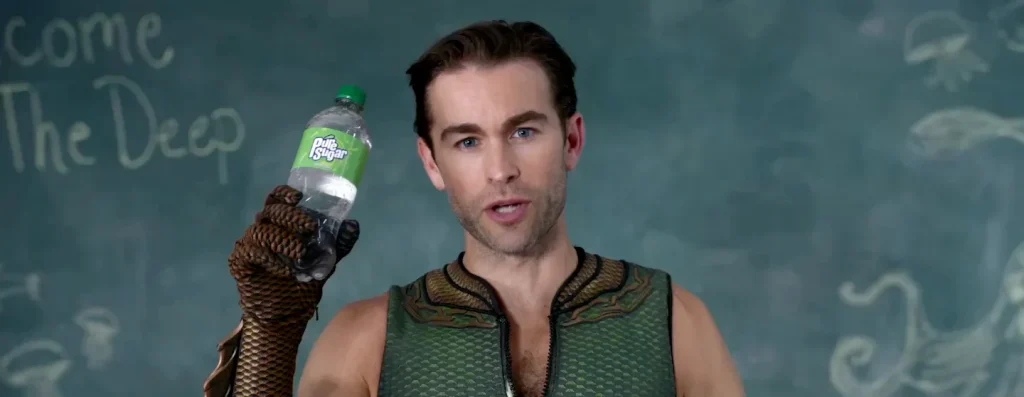This week, a daring superhero dives into the world of marketing, the fusion of haute couture and haute cuisine takes centre stage, new d*ck-pic etiquette is unveiled, and South Korea faces the unexpected consequences of overworked robots…
Deep In Liquid Death

How do you promote a show where one of your main characters has an intimate relationship with an Octopus? Ask The Boys marketing team.
The audience of the antihero show “The Boys” is well acquainted with jaw-dropping scenes that can only be brought to us by the mind of a twisted genius. Whoever that is, they have no problem sharing this with the marketing department.
In one of their latest collabs with Liquid Death, The Deep, a superhero with sea powers (aforementioned octopus lover), addresses the dangers of highly sugary drinks to kids. And in the typical style of the popular show, our hero f**ks up, forcing kids to eat raw sugar and turning a PG message into a chaotic scene.
But it didn’t stop there; the campaign between Liquid Death and The Boys continued on social media, with a public apology for Liquid Death, who claimed no creative direction and blamed everything on “Mr. The Deep.” The VP of Liquid Death got in on the action too, taking to LinkedIn to announce the termination of their partnership with the aquatic superhero.
This form of advertising brings fantastic engagement from the fans, as they go berserk seeing their characters step out of the screen and wreak havoc in the “real” world. It’s exactly the kind of crazy breaking-the-fourth wall advertising we can’t get enough of, and continuing the story across different channels is a stroke of genius!
Haute Cuisine Couture
Luxury brands are no longer just selling clothes; they’re selling an aspirational lifestyle. Food, particularly artisanal produce, symbolises sophistication, indulgence and exclusivity. Just last week, we spoke about LVHM’s acquisition of an old Parisian bistro.
If you’re following luxury fashion retailers on social media, you’d be hard-pressed to escape the increasing influence of the food industry on social photography. Sometimes no product will feature, such as Simone Rocha piped on a cake, or Loewe’s engraved artichokes.
While it may be a trend, seeing high-end fashion brands incorporate elaborate, edible set-ups in their visuals is an exciting reflection of how society embraces food outside the kitchen.
The rise of foodie culture has inspired many modern TV shows, such as The Bear and The Menu, which are fast becoming as much about fashion as they are about food, blurring the lines further.
However, it’s a trend that raises questions about authenticity, especially from an industry that has long villainised well… eating. But we’re here for the aesthetic, and it’s fair to say we’re hungry for more.
Cyber Flashing Be Gone

Image: Archer
Dating apps have a problem: men are far too eager to parade their private parts. Dating apps like Tinder had such a problem with cyber flashing that they were forced to ban all image sharing on the app.
Archer, a dating app designed for gay men, wants to keep things sofis-dick-ated on their app and is tackling d*ck picks head-on. The app uses AI to blur nude photos, giving the user the right to decide if they want to view them (like a shake to reveal, but for penises).
Archer launched their bold “Solicited D*cks” campaign this week, featuring striking billboards and social media teasers in major cities and popular gay bars.
The campaign is designed to raise awareness about consent while their social channels urge users to ask before sending. It’s a d*ck move we’re here for.
RIP (Rest In Pieces)

Image: Unsplash
A civil servant worker in South Korea has crashed itself into pieces due to burnout. It is reported to be the country’s first ‘robot suicide’ and has sparked discussions about the ethics of robotic labour.
The ‘Robot Supervisor’ was a well-oiled machine, a diligent worker performing an assembly line of tasks without breaks. It could easily navigate between floors, which made it stand out among its mechanic peers. Before the incident, a few witnesses claimed to have seen it distressed, circling in one spot as if concerned with something outside its robotic routine. It was then discovered at the bottom of a two-meter staircase, unresponsive after falling.
Known for a high robot density, South Korea has one robot per every ten human employees. Even robots need to power down every once in a while. After this incident, South Korea is considering introducing new regulations to ensure the well-being of our mechanical friends. Even robots need to power down every once in a while. With to-do lists longer than their circuit board, are we pushing them too hard? What happens if they run beyond their limits? Sounds like a start of a sci-fi thriller…

